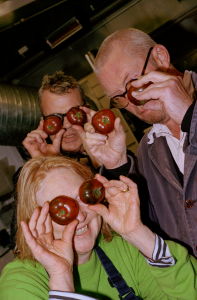Talking to the accomplished chef as he settles into his new position

Adam Simmonds initially turned to cooking as a teenager – something tangible and useful to turn to when struggling at school. That quickly grew into a remarkable career, with stops at the Ritz and Le Gavroche before arriving at the two-Michelin-starred kitchen Le Manoir aux Quat’Saisons under Raymond Blanc.
He’s gone on to win Michelin stars of his own: first at Ynyshir Hall and later at Danesfield House. He left to experiment for a few years – opening Soho’s Test Kitchen alongside a number of head chef roles, but this month finds himself Chef Patron at The Megaro.
A new restaurant is on the cards for later in the year, but until that opens he’s turned his attention to reinvigorating the property’s existing Italian restaurant, Spagnoletti. Port caught up with Adam on his cooking roots and his budding plans for the future.
What drew you to cooking?
I was not an academic young man and struggled to keep still in class. However, I found home economics incredibly interesting. Truth be told, I loved it because there were more girls than boys, but I genuinely enjoyed the practical aspects of the course. Being actively engaged and not needing to focus on text made me want to pursue this further.
I left school at 16 and went to culinary college, earning my City & Guilds qualifications. During this time, a seed was planted, and my passion began to grow. I realized that I thoroughly enjoyed hands-on work and wanted to chase this feeling, starting a career in the field.

You’ve had quite the route through kitchens – working under Raymond Blanc, winning two Michelin stars: what do you feel are the most important things you’ve learnt along the way?
The hospitality industry has changed since I started! I was working as a Sous Chef in London when I had the opportunity to join Raymond at Le Manoir. I was offered a chef de partie role there, and I gladly took that step, conscious that knowledge is power. I learned as much as I could from him and his brigade and moved on to achieve accolades and participate in competitions on TV shows.
I was only 31 years old when I first had my Head Chef role at The Green Way in Cheltenham. I must admit, I was like a bull in a China shop! I had a massive ego when I was younger, but life taught me that you need to work hard and master your craft thoroughly before you take bigger steps.
I have learned that the key to success is being humble. The team is your biggest asset and treating them all with great respect is paramount to receiving it in return. Shouting or screaming does not lead anywhere. It is vital not to push them but to have an understanding and empathetic approach, mentoring and leading them towards common success by sharing my knowledge.
You’re mixing things up at Spagnoletti as a first move – what’s your thinking behind the changes, and what do you hope people find in it?
First and foremost, I am introducing a new concept that I believe fits perfectly with Spagnoletti. This concept will give the team clear direction and a distinctive personality. I am bringing a lightness of touch to the dishes, promoting sustainability, seasonality, texture, and flavour through modern presentation and consistency. The menu is a journey, starting with light and delicate flavours and moving towards a more robust, richer selection. Similarly, a mix of powerful and more gracious flavours is also present on the dessert menu.
I hope our guests will perceive the quality and honesty of our contemporary Italian cuisine, paired with a slick, friendly, and welcoming environment.

Is there any one menu item that encapsulates what you’re hoping to do at the new Spagnoletti, and could you expand on how, if so?
I believe that the Scallop Raviolo, with its lightness of touch and fantastic produce, represents my style of cooking and what Spagnoletti stands for. Homage to the late Gualtiero Marchesi , the dish embodies clarity, freshness, and simplicity on a plate. The combination of ingredients makes it highly seasonal, and although its appearance may convey straightforwardness, it is a highly technical dish.
It is all about timing and precision with this one: the pasta needs to be rolled thin enough, the scallops must be of the correct thickness, and the morels must be precisely prepared. The chef must work meticulously with the heat during each stage of the cooking process, allowing the pan to do the work.
I know ingredients are important to you – how are you approaching sourcing at The Megaro?
I have a strong relationship with suppliers that I have built along the way. Although I have my trusted ones, I keep an open mind and am committed to staying up to date with new entrants in the market and assessing how they operate. At Spagnoletti, we source as locally as we can while keeping our Italian cuisine connected to its origins by importing specific ingredients, such as our charcuterie selection, which is constantly changing.
It’s a priority for me to work closely with suppliers, understanding where the ingredients are sourced, considering sustainability aspects, packaging, and pricing (of course), but most importantly, ensuring that our partners are as respectful as we are towards the produce itself. It is so much more than just supplying food.

Finally, could you give us any hints about what’s coming later in the year?
Making my mark in London with something new, fresh, and contemporary. I am bringing my renewed self to the forefront… you will have to wait and see.




